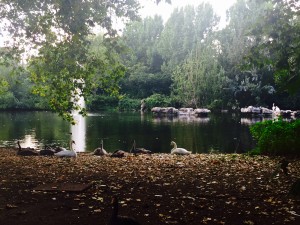Day three in London, I coax my brother into a morning run. Two of my siblings are regular runners, but we’ve never gone together. He’s faster, by a solid minute per kilometer or more, so I’m nervous. I’m injured, he says. I have to be careful about the impact on my legs.
So now if trail behind, too far to even see the dust he kicks up, I can rest assured that an injured runner is trouncing me. I remind myself this was my idea.
 We walk to Regent’s Park where we’ll run. There are plenty of parks in Toronto, but I’ve never done this, walk to the start line. Unless, of course, it’s a race day.
We walk to Regent’s Park where we’ll run. There are plenty of parks in Toronto, but I’ve never done this, walk to the start line. Unless, of course, it’s a race day.
Once surrounded by the vibrant greens produced by daily rain, we set our pace. It’s slow, steady. I know he’s holding back. But a slower gait allows for easy conversation. We start talking about running clinics. He mentions one he knows of in the city. My city. They record you on a treadmill and then correct your form with red ink.
The price tag makes me stumble, so I inquire further, seeing what tips I can pick up from someone who’s already shelled out the cash. Well, for starters, he says, your foot strikes the wrong spot on every step.
For starters? The wind leaves my lungs.
He explains further. When your heel hits the ground first, you’re forcing two to three times your weight onto a bone that’s not designed to take that much impact. It also often leads to over-striding. Striking on the mid- or forefoot helps you take smaller steps, leaning forward to increase speed rather than the temptation to widen your gait.
But that’s not all. Running toe-first keeps your knees bent, which enhances the storage and use of energy.
I make the switch and quickly feel ridiculous, like I’m prancing through the park. I watch people around us as we run, but no one is staring at the deer-in-training. I sink into our pace with my new stride, feeling energy rising from my feet and up through my legs like the red of a thermometer.
And, because this is how my mind works, I throw a fishing line out to catch the deeper meaning. Most people instinctually run heel-first (later research reveals this stat to be 95%). We get the job done but maximize the negative impact and minimize our energy for the next step. We unnecessarily risk injury, our wide strides reducing how far and how fast we can go. We choose the hard way, without even realizing it.
I’ve been running for two and half years, never once thinking there was a gentler, more efficient way to do it. What else am I approaching with the same force, thinking it’s a sign of strength but, in reality, it makes me weaker?
And there it is: catch of the day. I tend to charge at things I want or believe in with full force, sometimes with no thought to how each step should be taken. I argue easily. I don’t back down. I can be wickedly stubborn. I’m not usually a detail-oriented person. I’m a runner. I see an end goal and take off. It’s a race. And I’m in it to win it.
But, if Baz Luhrmann is right, then the race is long. And in the end, it’s only with yourself. If I could run beside a mirror, study each step and learn a kinder but faster stride, imagine how much further I could go before my body cries enough.
After a loop around the park, we race to the lights. I lose, but in so many ways, I also win.

Glad to see you are interacting together, and learning something new. We never like to admit that an older brother can actually teach us something new………..speaking from experience. Enjoy your time together.